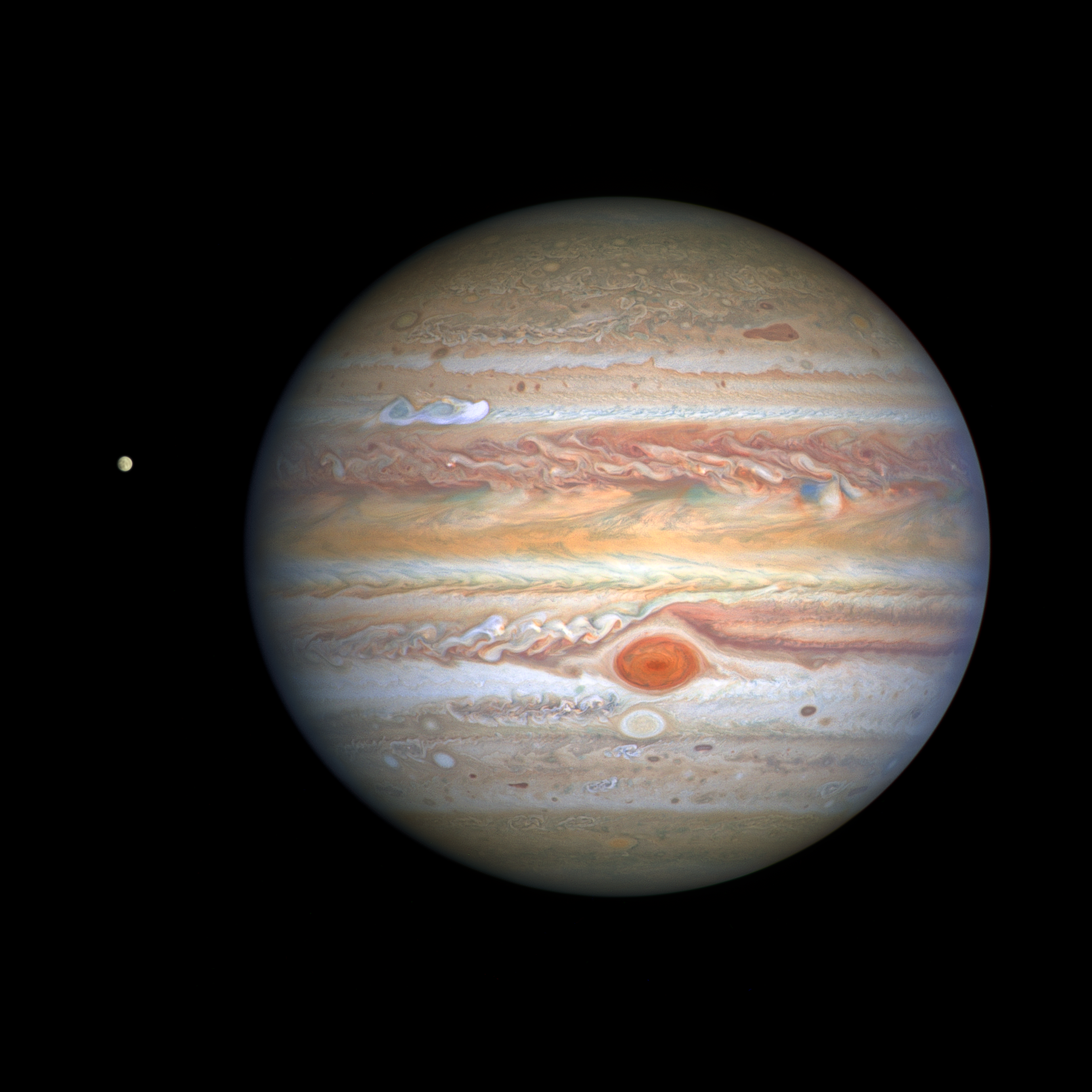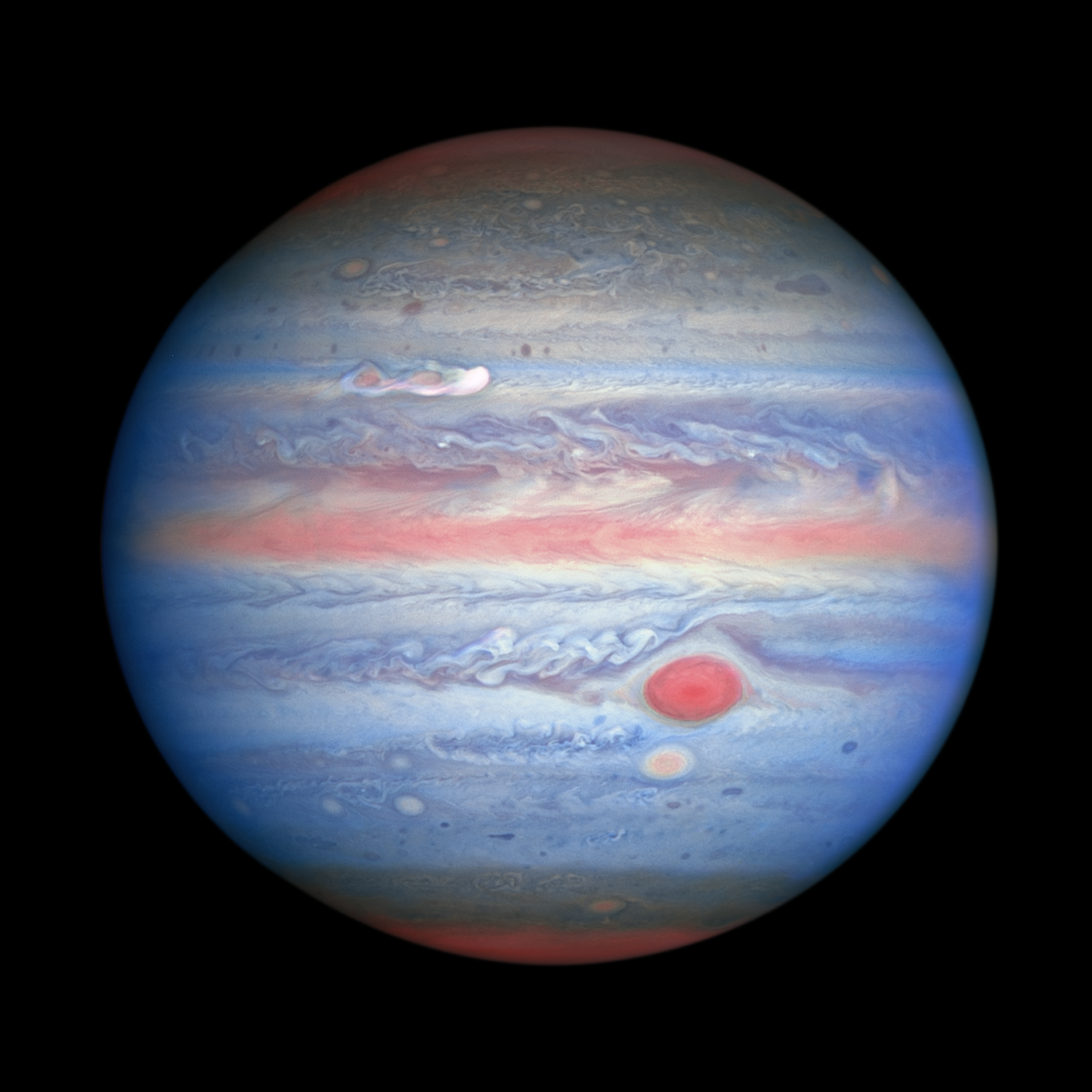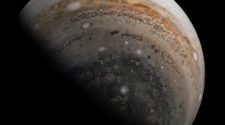
A spectacular new image of Jupiter was taken last month by NASA’s iconic Hubble Space Telescope (HST), which celebrated its 30th year of operation during 2020. The image unveils never-before-seen detail, including a newly formed giant white-colored turbulent storm swirling at over 300 mph in the northern latitudes as our solar system’s largest planet was approximately 400 million miles from Earth.
Another tantalizing bonus featured in the latest image is Jupiter’s icy moon Europa – which may hold potential ingredients for life, visible to the left of the gas giant in the Hubble image shown above.
“Hubble’s sharp view is giving researchers an updated weather report on the monster planet’s turbulent atmosphere, including a remarkable new storm brewing, and a cousin of the famous Great Red Spot region gearing up to change color – again,” NASA announced in a Sept. 17 press release.
The newly released snapshot of the Jovian giant was taken on Aug. 25, 2020, by the Earth-orbiting Hubble Space Telescope observatory at a distance of 406 million miles (653 million kilometers).
The monstrous new storm is located at mid-northern latitudes as a bright, white, stretched-out storm traveling around the planet packing enormous speeds of 350 mph or 560 kilometers per hour – and can be seen at the upper left part of Jupiter in these freshly taken Hubble views.

This single plume erupted on Aug. 18, 2020 – and ground-based observers have discovered two more that appeared later at the same latitude, according to a NASA news release. While it’s common for storms to pop up in this region every six years or so, often with multiple storms at once, the timing of the Hubble observations is perfect for showing the structure in the wake of the disturbance, during the early stages of its evolution. Trailing behind the plume are small, rounded features with complex “red, white, and blue” colors in Hubble’s ultraviolet, visible, and near-infrared light image. Such discrete features typically dissipate on Jupiter, leaving behind only changes in cloud colors and wind speeds, but a similar storm on Saturn led to a long-lasting vortex. The differences in the aftermaths of Jupiter and Saturn storms may be related to the contrasting water abundances in their atmospheres, since water vapor may govern the massive amount of stored-up energy that can be released by these storm eruptions.
Meanwhile, Hubble continues to document the shrinking size of the Great Red Spot – currently 9800 miles in diameter. Scientists have no idea why the Great Red Spot super storm has been getting smaller since the 1930s. And while it is shrinking, the entirety of the Earth could still easily fit inside the Great Red Spot.
Hubble shows that the Great Red Spot, rolling counterclockwise in the planet’s southern hemisphere, is plowing into the clouds ahead of it, forming a cascade of white and beige ribbons. The Great Red Spot is currently an exceptionally rich red color, with its core and outermost band appearing deeper red.
“Hubble’s new images of Jupiter capture the giant planet’s stormy atmosphere. The Great Red Spot, a storm big enough to swallow Earth, is still shrinking. Beneath it, “Red Spot Jr.” continues to rage and change color, while a new storm brews in the north,” NASA tweeted with a video.
Hubble's new images of Jupiter capture the giant planet’s stormy atmosphere.
The Great Red Spot, a storm big enough to swallow Earth, is still shrinking. Beneath it, “Red Spot Jr.” continues to rage and change color, while a new storm brews in the north: https://t.co/Zg6i8mv61S pic.twitter.com/ySyVuemtcb
— Hubble (@NASAHubble) September 17, 2020
Another feature researchers are noticing has changed is Oval BA, nicknamed by astronomers as Red Spot Jr., which appears just below the Great Red Spot in this image. For the past few years, Red Spot Jr. has been fading in color to its original shade of white after appearing red in 2006. However, now the core of this storm appears to be darkening slightly. This could hint that Red Spot Jr. is on its way to turning to a color more similar to its cousin once again.
Hubble’s image shows that Jupiter is clearing out its higher altitude white clouds, especially along the planet’s equator, where an orangish hydrocarbon smog wraps around it.
The icy moon Europa, thought to hold potential ingredients for life, is visible to the left of the gas giant in the new image. A salty ocean is believed to lie beneath Europa’s icy shell and is the subject on NASA’s upcoming Europa Clipper mission – and is a prime target in the search for life.
In another NASA mission, the solar-powered Juno spacecraft is still orbiting Jupiter to help determine the planet’s genesis.
This newest Hubble image is part of annual maps of the entire planet captured for the Outer Planets Atmospheres Legacy program (OPAL). The program provides yearly Hubble global views of the outer planets to look for changes in their storms, winds, and clouds.” Hubble is a joint mission between NASA and ESA, the European Space Agency.
Currently, Jupiter is visible in the evening skies as the brightest planet currently – with a golden hue as one looks south. To the left of Jupiter is the ringed planet Saturn sporting a yellowish tinge.



